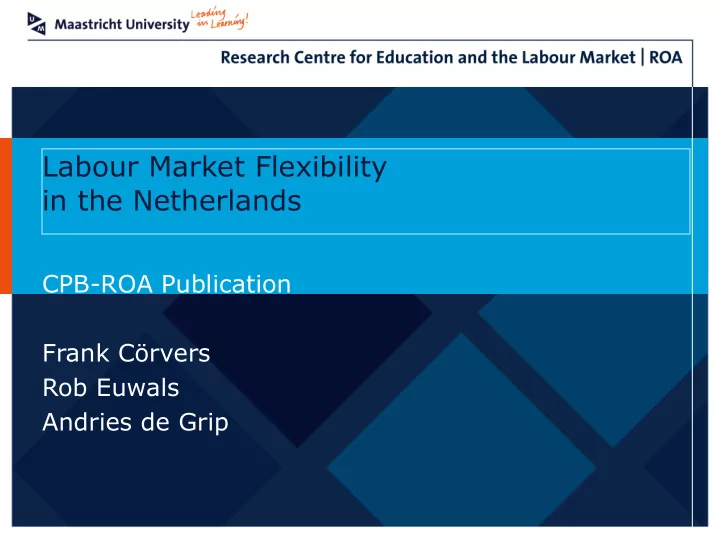

Labour Market Flexibility in the Netherlands CPB-ROA Publication Frank Cörvers Rob Euwals Andries de Grip
Overview (continued) 4. Flexible contracts: recent graduates 5. Flexible contracts: human capital 6. Conclusions 2 Flexibility of the Labour Market 21 January 2011
(4) Flexible contracts among recent graduates: fixed-term & twa Facts • Flexible contracts are very common among recent graduates • In general: Less paid, worse job match, etc. • Exception for job match: university graduates in fixed term contracts Research questions • Reasons for the selection of recent graduates into flexible contracts? • Demand or supply driven? 3 Flexibility of the Labour Market 21 January 2011
(4) Incidence of flexible contracts among recent graduates 4 Flexibility of the Labour Market 21 January 2011
(4) Wage difference of flexible contracts relative to permanent contracts 5 Flexibility of the Labour Market 21 January 2011
(4) Flexible work differs by level and field of study and can be explained by the positive impact of • Employment variation • Weak labour market position: unemployment, attachment to occupations • Lower ability of graduates • Graduates’ willingness to take risks has no impact! • Controlled for gender, age, ethnicity, region, year of survey 6 Flexibility of the Labour Market 21 January 2011
(4) Exception: university graduates in fixed-term contracts • Labour demand is less important • Better job match • Selection of higher able graduates into fixed-term instead of permanent contracts • Examples of screening of graduates in fixed-term contracts: traineeships at hospitals, PhD positions at universities 7 Flexibility of the Labour Market 21 January 2011
(4) Relevant for policy discussion • Recent graduates are used as a buffer for employers to deal with fluctuations in the demand for personnel: high and time-varying probability of flexible contracts • Only for university graduates in fixed-term contracts: screening by employers is important • No match between preferences of graduates and their contracts 8 Flexibility of the Labour Market 21 January 2011
(5) Flexible contracts: human capital Five contract types in the labour force • Permanent contracts • Temporary contracts • Temporary work agency contracts • On-call contracts • Self-employment without personnel 9 Flexibility of the Labour Market 21 January 2011
(5) Training participation Fact • Training participation is lower among flexworkers Research questions • Role of employer-funded versus self-paid training in training participation? • Do training investments of flexworkers improve their internal or external employability? 10 Flexibility of the Labour Market 21 January 2011
(5) Who pays? Training participation Who pays for the training? (Partly) Employer Self Other Permanent employment 12 78 14 1 Temporary work agency employment 10 53 39 5 Temporary contract 10 51 39 6 On-call employment 9 62 29 7 Self-employed without personnel 6 26 64 8 Source: Statistics Netherlands, LFS 2004-2008 11 Flexibility of the Labour Market 21 January 2011
(5) Training and labour market mobility for flexworkers Other Other Same employer / employer / employer / permanent flexible permanent Not employed contract contract contract Temporary work agency (ref.) Temporary contract − − − On-call employment − − − + Employer-financed training − + Self-financed schooling + + Controls for individuals, job, and firm characteristics included Source: Statistics Netherlands, LFS 2006-2007 / 2008-2009 12 Flexibility of the Labour Market 21 January 2011
(5) Relevant for policy discussion • Quantitative labour market flexibility is empirically related to lower training participation • Training gap of flexworkers is due to lack of employer-financed training • Flexworkers more often pay for their own training, but training gap is not fully compensated by own training investments • Employer-financed training provides stepping stone to permanent contract • Self-paid training is related to flexcontract with other employer and to unemployment 13 Flexibility of the Labour Market 21 January 2011
(6) Conclusions 14 Flexibility of the Labour Market 21 January 2011
(6) Issues for further research • Explanations for why wage-tenure profiles differ between countries and between empirical studies • In particular: role of human capital investments and institutions • Self-employment as a last or new step in a working career? • Optimal mix of various types of contracts? • Development of a theoretical model with a role for different types of labour contracts 15 Flexibility of the Labour Market 21 January 2011
Recommend
More recommend